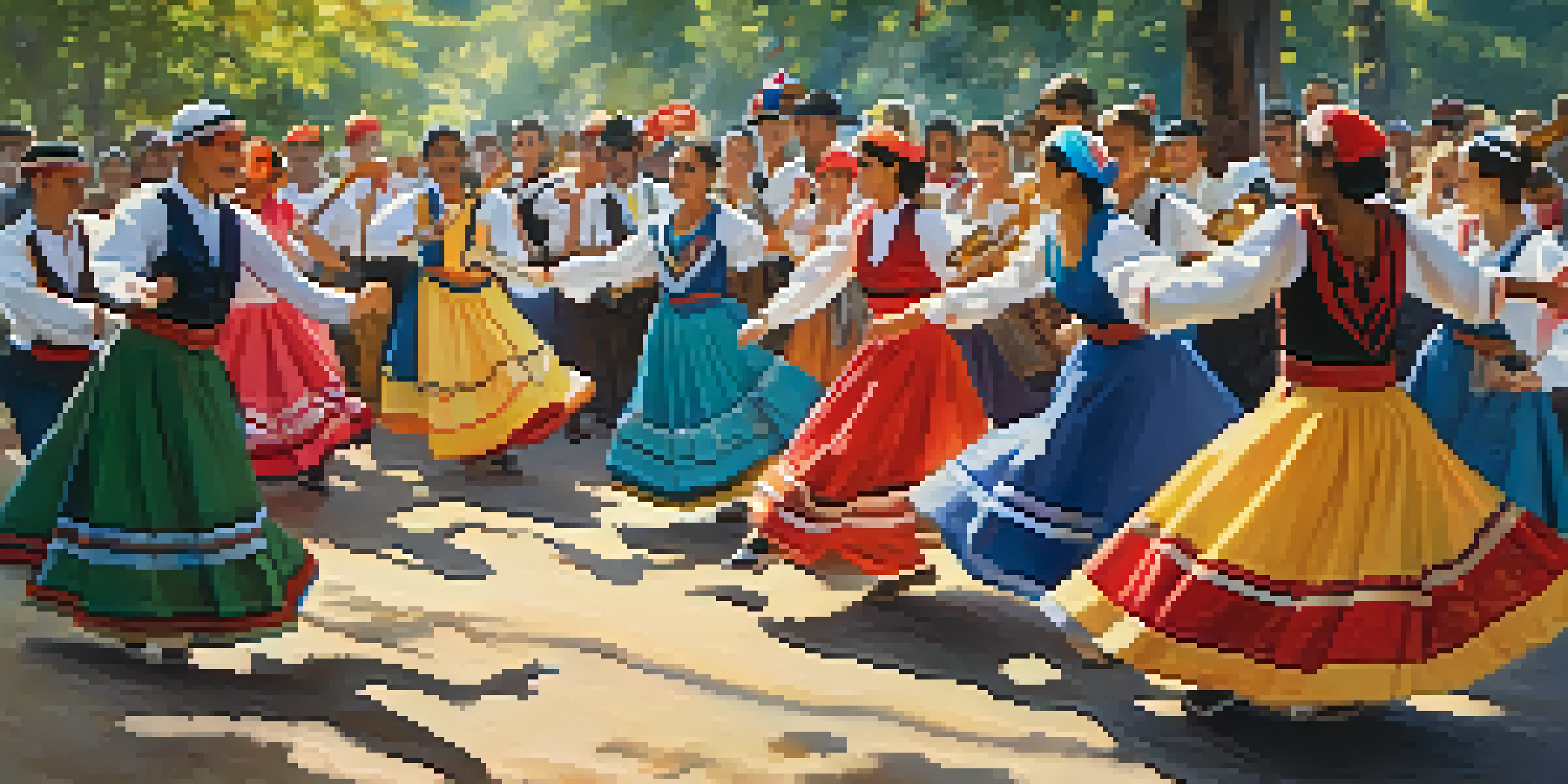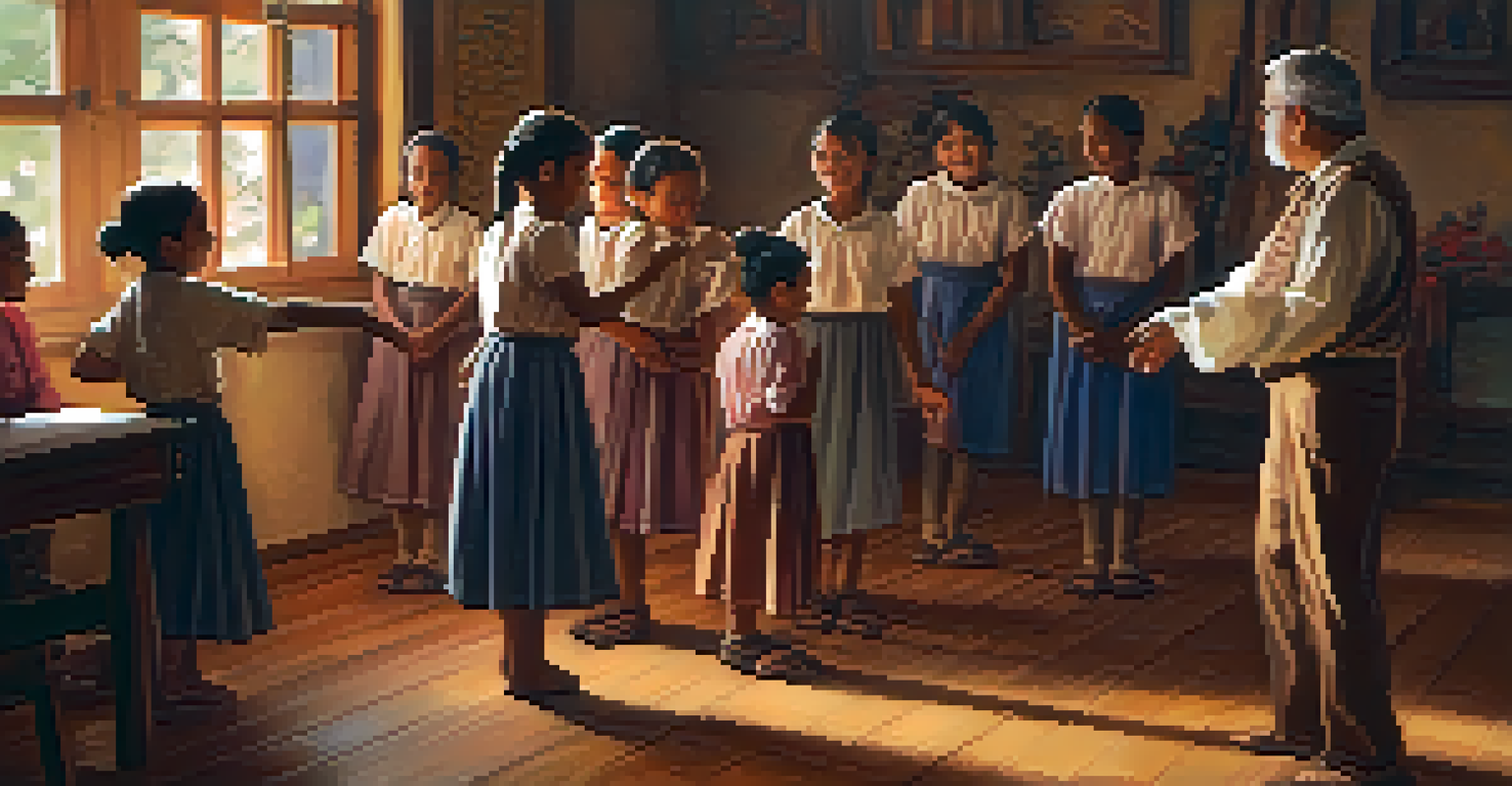Exploring the Evolution of European Folk Dance Traditions

The Roots of European Folk Dance: A Historical Overview
European folk dance traditions have deep historical roots, often tracing back to communal celebrations and rituals. These dances were not just forms of entertainment; they served as a means of storytelling, passing down cultural values, and fostering community spirit. For instance, many dances were linked to agricultural cycles, celebrating harvests or seasonal changes.
Dance is the hidden language of the soul.
In various regions, local customs shaped the style and form of these dances. In the Balkans, for example, lively group dances like the 'Kolo' reflect the vibrant social fabric of the area. Similarly, the Irish 'Ceili' dances emphasize community involvement, showcasing the importance of togetherness in these traditions.
Over time, as societies evolved and modern influences crept in, many folk dances began to change. While some communities maintained strict adherence to traditional forms, others adapted their dances to include contemporary elements, leading to a rich tapestry of styles across Europe.
Regional Variations: A Closer Look at Folk Dances
Each European region boasts unique folk dances that reflect its cultural identity. For example, the spirited 'Samba' in Portugal showcases lively footwork and intricate patterns, while the elegant 'Polka' from Central Europe features a distinct two-step rhythm that has captivated audiences for generations. These dances often tell stories or celebrate local legends.

In Scandinavia, the 'Halling' dance is a prime example of acrobatic flair combined with traditional steps, often performed at festivals and gatherings. Its energetic movements not only entertain but also foster a sense of pride in local heritage. Similarly, the 'Sirtaki' from Greece combines traditional and modern elements, making it a favorite among tourists and locals alike.
Folk Dance: A Cultural Heritage
Folk dance traditions are vital for preserving cultural identity and fostering community spirit across Europe.
These regional variations highlight the diversity within European folk dance traditions. While they share common roots, each dance brings its own flavor and history, enriching the overall tapestry of European culture.
The Role of Music in Folk Dance Traditions
Music plays a pivotal role in shaping folk dance traditions across Europe, often dictating the rhythm, tempo, and style of the dance. Traditional instruments like fiddles, accordions, and bagpipes create a lively atmosphere that invites participation. For instance, the upbeat tunes of a fiddle can inspire spontaneous dancing during local festivals.
Tradition is not the worship of ashes, but the preservation of fire.
In many cultures, specific dances are paired with particular musical styles. In Scotland, for example, the 'Highland Fling' is performed to the sounds of traditional bagpipe music, enhancing the experience and connecting dancers to their heritage. In contrast, Italian Tarantella dances often feature lively tambourines and guitars, creating a festive ambiance that encourages communal participation.
As folk music evolves, it influences the dance styles associated with it. Contemporary artists often blend traditional melodies with modern genres, creating new interpretations that resonate with younger generations while preserving the essence of their cultural origins.
Folk Dance as a Means of Cultural Preservation
Folk dance serves as a vital tool for preserving cultural heritage, especially in an age of globalization. Communities often organize workshops and festivals to teach younger generations about their traditional dances, ensuring that these practices are not lost to time. This transmission of knowledge fosters a sense of identity and continuity.
Organizations and dance groups across Europe actively work to keep these traditions alive. For instance, the 'International Council of Organizations of Folklore and Folk Arts' promotes the importance of preserving folk dance as a cultural expression, encouraging communities to engage with their roots. These efforts highlight the role of folk dance in maintaining cultural diversity in a rapidly changing world.
Music's Role in Folk Dance
Traditional music deeply influences folk dance styles, enhancing the experience and connecting dancers to their heritage.
Moreover, folk dance often serves as a bridge between generations, allowing older members to share stories and experiences with youth. This intergenerational connection enriches both the dance practice and the community, creating lasting bonds based on shared culture and history.
Modern Adaptations: Folk Dance in Contemporary Society
In recent years, there has been a noticeable revival of interest in folk dance, particularly among younger audiences. Many contemporary choreographers are drawing inspiration from traditional dances, infusing them with modern elements to create exciting new performances. This blend of old and new not only captivates audiences but also encourages participation.
Social media platforms have played a significant role in this revival, allowing folk dances to reach a global audience. Viral dance challenges often incorporate traditional steps, making them accessible and appealing to a wider demographic. This newfound popularity helps keep the spirit of folk dance alive and thriving in contemporary culture.
However, this modernization comes with its challenges. Some purists argue that altering traditional forms dilutes their cultural significance. Balancing innovation with authenticity remains a delicate dance in itself, as communities navigate the ever-evolving landscape of folk dance traditions.
Folk Dance Festivals: Celebrating Tradition and Community
Folk dance festivals serve as vibrant celebrations of cultural heritage, bringing together dancers, musicians, and audiences from various backgrounds. These events not only showcase traditional dances but also foster a sense of community and shared identity. For example, the 'European Folk Dance Festival' attracts participants from across the continent, providing a platform for cultural exchange and collaboration.
During festivals, attendees often engage in workshops, learning new dances and immersing themselves in different cultures. This hands-on experience helps to bridge gaps between generations and fosters a spirit of camaraderie among participants. In this way, folk dance festivals not only celebrate tradition but also encourage cultural dialogue.
Modern Revival of Folk Dance
A resurgence of interest in folk dance among younger generations is blending traditional elements with contemporary styles.
Moreover, these festivals often feature competitions, highlighting the skill and artistry of dancers. This competitive element can inspire performers to push the boundaries of their craft while honoring their roots, creating a dynamic environment that celebrates both tradition and creativity.
The Future of European Folk Dance Traditions
As we look toward the future, the evolution of European folk dance traditions is likely to continue. The blending of traditional forms with contemporary influences will shape the way these dances are performed and perceived. This ongoing transformation can lead to exciting new interpretations that resonate with younger generations while preserving essential cultural elements.
Educational initiatives aimed at teaching folk dance in schools and communities will play a crucial role in ensuring these traditions endure. By introducing children to their cultural heritage, we foster appreciation and interest that may lead to lifelong passion for dance. Engaging with folk dance can create a sense of belonging and identity that is vital in today’s increasingly globalized world.

Ultimately, the future of European folk dance traditions lies in the hands of the communities that cherish them. As long as there is a commitment to honoring the past while embracing the present, folk dance will continue to thrive, echoing the vibrant stories and experiences of generations to come.